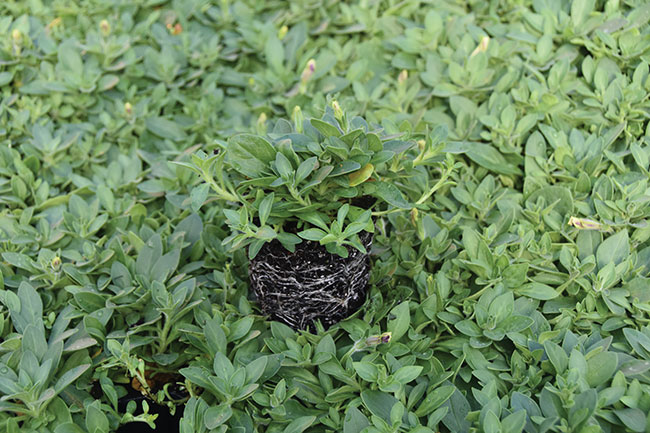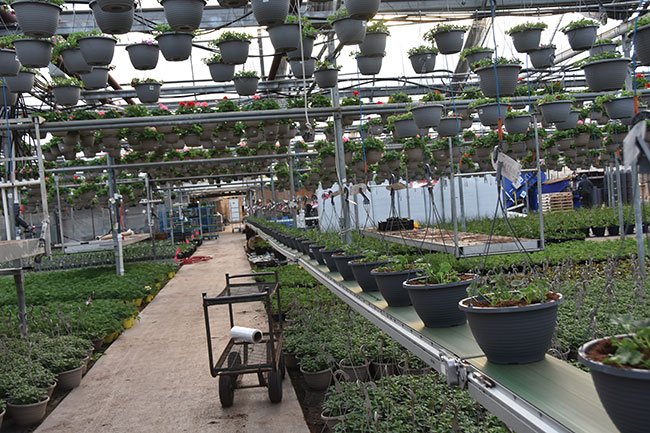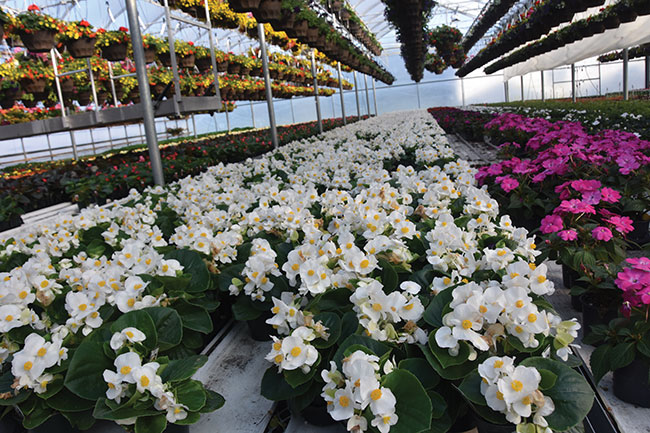
Features
Business
Management
Filling in the gaps of your business profit margins
Making key changes in different areas of your greenhouse can streamline your business.
September 28, 2021 By Melhem Sawaya
 Starting with healthy plant material can save on many costs along the way.
all photos: m sawaya
Starting with healthy plant material can save on many costs along the way.
all photos: m sawaya Although most of the decisions and planning for the following year take place over the summer months, it’s always a good idea to think about areas of your business where you can make improvements.
The degree of this process’ success depends on a number of factors, including:
- The notes we kept during the previous year on what to improve, change or discuss.
- Meaningful, effective planning sessions that hinge on how much we were in touch with daily activities of the business.
- Involving and taking into consideration the opinions of people who do the work.
- Making a good effort to find out how other operations corrected the same issues and whether you can apply it to your operation. Or check as many resources as possible to get a more informative handle on the situation. There is nothing wrong with copying and improving if you are willing to share your knowledge with others. Cooperation only works if it is mutually beneficial.
Some decisions do not require any capital expenditure, like hiring or letting go of an employee, or adjusting job positions. However, many decisions do need capital investment, and they fall into the following categories:
- Necessary/no choice – like a new boiler, changing plastic, a proper water source, or a broken and unfixable pot/flat filler.
- Upgrading for efficiency purposes.
- Installing a new system that will reduce costs.
- New technology that will improve plant quality.
When reviewing your greenhouse operation each year, it can be helpful to look at the different parts which make up the greenhouse operation, namely: infrastructure, sales and marketing, production, labour, and general overhead.
For a small operation, it is likely that one or two people handle all of these areas, while in bigger operations more than one individual could be responsible. Independent of size, when reviewing and planning for the upcoming year or five years, it would be helpful to think through these operations one by one.
Infrastructure
Even if a greenhouse has been built for a long time, expansion can sometimes be an opportunity to move the receiving and shipping area, change up the driveways, or move the washrooms closer to where the action is. The point is, always think outside the box and many new ideas will surface.
In terms of energy, certain circumstances could present opportunities for cogeneration, wood boilers or extending that gas line to your operation. These are major projects, but if the pay back is in three to five years, the expansion is justifiable.
Sales and marketing
Always evaluate your customer base. Identify the very needy and least profitable, but at the same time, be sure to show your appreciation to the ones who have served your business and are part of your success.
Evaluate your product mix by calculating cost and profit margins. Eliminate the low- or negative-profit margin items if there is no room for increasing the selling price or reducing costs.
Keep your options open for different customers, but never flip-flop for no reason or over minor disagreements.
Involve your customer in product selection, and in return your customer will involve you in their product selection.
The costs of running a greenhouse business keep going up, especially in the last two to three years. This is mostly due to the costs of labour and shipping. In addition, the price of supplies will be going up drastically next year, and that includes plant material, seed, containers, and growing media. Expect an increase of 11 to 25 per cent in production costs this coming season! Share these cost increases with your customers now so you can at least recover it.

Conveyor belts can help save time spent on routine tasks.
Production
With all the costs that are forced onto us, we should always look for more effective ways to be efficient. Here are some suggestions:
Offer less: Streamline the products you offer. This is the only way to reduce shrinkage and be able to mechanize. It will reduce inventory, lessen down time at planting, and speed up shipping.
Do not jump into new varieties without first trying them at your own operation. Then if all goes well and they have market appeal, make them part of your production. It has been proven that growing new varieties without trying them first is a major profit robber.
Time it well: Mum growers and poinsettia growers understand photoperiod very well. When it comes to bedding plants, photoperiod has not been well-adopted for proper timing of crops. One example is the African marigold, which is planted using short days to initiate flowering. This adds three weeks to crop timing, and as a result, the crop is too old when shipped. The alternative is to blackout the plugs for three weeks, which will initiate flowering and take another four weeks to finish. A lack of knowledge in photoperiods turns a crop of seven weeks into 10 weeks, and the flowers become too old at shipping due to production timing.
Timing the crops to meet shipping targets without added treatments or extra work, like pinching, is a very inexpensive way to save money and still end up with a fresh product that will do well for the consumer. Aged product will dry out faster and will be much harder to acclimatize in the garden setup, in addition to the extra costs of production.

Overflowering begonias can either be due to wrong timing or wrong variety.
Grow to capacity: Grow the volume of product for which the greenhouse area allows and don’t exceed it. This saves a lot of the extra labour spent moving product around and prevents you from sacrificing product quality. Exceeding that capacity might work for one year, but it generally won’t in the next and in the process, you might be labeled as a grower with low quality product. It is hard enough to hold onto a reputation for good quality, and much harder still to recover from inferior quality.
Consider the consumer: When you fill larger pots for product that is not intended for planting in a garden, it is especially useful to scoop out some growing media from the container to leave room for the water when the consumer is watering by hand. This gives the product a better chance at survival, and in doing so, you will be saving at least 15 per cent of the media.
There is no need for saucers in the hanging baskets, especially for outdoor use. The little bit of buffer is false security for the homeowner and does nothing to improve production in the greenhouse.
Planting healthy plugs or liners into the final container is the best way of insuring that the crop stays healthy all the way through finish, without any chemical treatment. My customers use fungicides very rarely, concentrating on solving the cause of the problem rather than treating it as insurance. Routine fungicide treatments could add up to high costs and sometimes with negative side effects.
Use the pot size to suit the cultivar you are planning to grow. If a variety is very vigorous, then it should be planted into a larger pot rather than a smaller one. Treating it three to five times to keep it short will most likely mean that it will not grow for the consumer afterwards. At the same time, do not use very compact varieties in large pots unless you plan to put more liners or plugs in each pot.
Combinations: Combinations are the most popular item among all bedding plant offerings. To be profitable, here are some guidelines:
Two cultivars in one pot are considered a combination. There is no need to put five to six different cultivars in one container. The vigorous cultivars will take over and hide the others, and it will also make growing difficult. Breeders are doing a much better job in suggesting combinations where the cultivars are compatible, but nothing takes the place of trialing them first.
Three cultivars are optimal for combinations and the best ones are those from the same genus, like three differently coloured calibrachoas or three different petunias.
A profitable combination is the one we plant and ship in six to eight weeks without any, or just one, growth regulator treatment.
There is no place for combinations in 10” hanging baskets or pots. Combinations are an upgraded item and belong in containers 12” and up because we still charge by pot size rather than what is in it. The difference in price between the 10” and 12” is $4 to $5.
Combinations can be made from seed items, which normally are less expensive than vegetative plant material, or a combination of the two.
Combinations of just foliage materials are becoming extremely popular and are normally fast-growing, which could be good reasons to try them.
Planting combinations of varieties with the same growth vigour is best. Second best is knowing the vigour of the plant material going into the combination, then applying a growth regulator before planting the more vigorous ones to balance out the combination’s growth. This will save time later and be more cost-effective.
Labour
The best way to save on labour is to minimize it by streamlining production. Reduce the time spent handling the product. Instead, write up your production programming in detail and perform tasks on time. Create and follow best practices.
With mechanization, be sure to get the necessary tools and do the job right the first time. Have the proper structure in place, such as belts, concrete aisles and floors, as well as functioning machinery to reduce down time. By mechanizing routine jobs, you can hold onto qualified staff.
Don’t be afraid to eliminate the bad apples who can drag down good employees. Lead by example, and most importantly, set goals for employees and reward the achievers.
General overhead
This category includes all indirect costs. Independent of how full or not full the greenhouse is, these costs remain the same and include items such as accountants, consultants, mortgages, and lawyers. These people are there for one reason and that is to help you, but they are only as good as your interactions with them. Ask questions that you need answers to.
What has worked for me all my life is the LALA theory, which stands for: Look, Ask, Listen, and Act.
For all of these tips to work, you must always believe that there is a better way for doing everything that you do. The minute you think you know it all, it is the beginning of the end
Melhem Sawaya of Focus Greenhouse Management is a consultant and research coordinator to the horticultural industry. He can be reached at mel@focusgreenhousemanagement.com.
Print this page